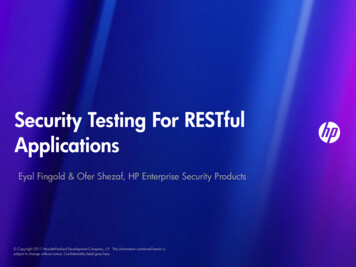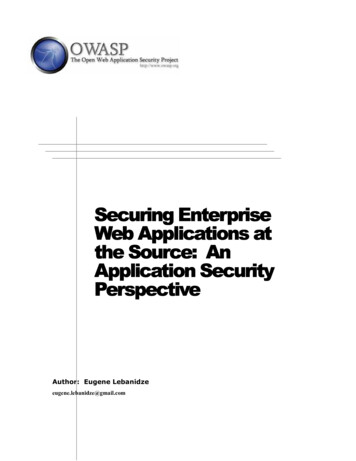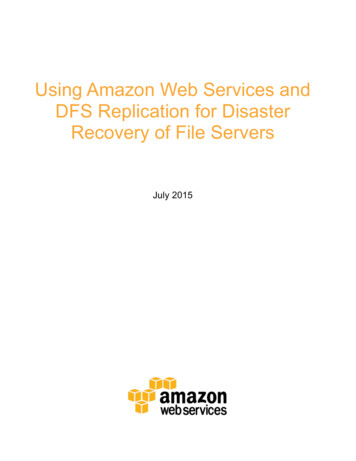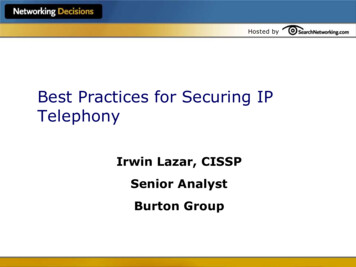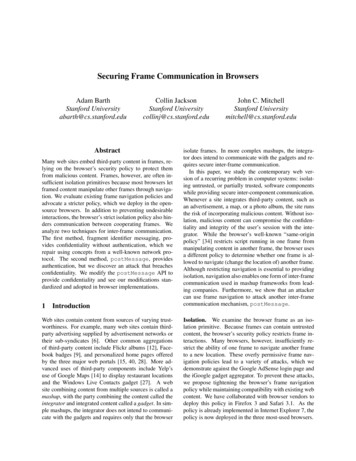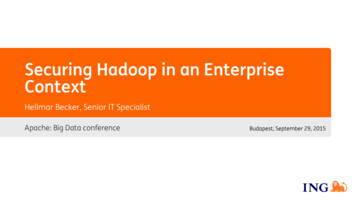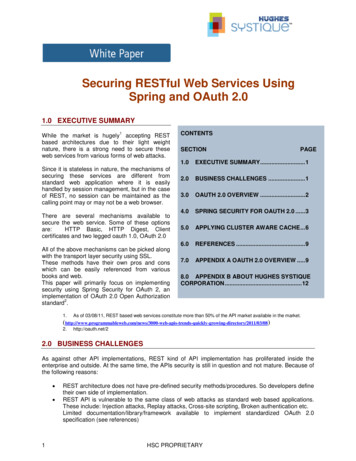
Transcription
Securing RESTful Web Services UsingSpring and OAuth 2.01.0 EXECUTIVE SUMMARY1While the market is hugely accepting RESTbased architectures due to their light weightnature, there is a strong need to secure theseweb services from various forms of web attacks.Since it is stateless in nature, the mechanisms ofsecuring these services are different fromstandard web application where it is easilyhandled by session management, but in the caseof REST, no session can be maintained as thecalling point may or may not be a web browser.There are several mechanisms available tosecure the web service. Some of these optionsare:HTTP Basic, HTTP Digest, Clientcertificates and two legged oauth 1.0, OAuth 2.0All of the above mechanisms can be picked alongwith the transport layer security using SSL.These methods have their own pros and conswhich can be easily referenced from variousbooks and web.This paper will primarily focus on implementingsecurity using Spring Security for OAuth 2, animplementation of OAuth 2.0 Open Authorization2standard .1.CONTENTSSECTIONPAGE1.0EXECUTIVE SUMMARY . 12.0BUSINESS CHALLENGES . 13.0OAUTH 2.0 OVERVIEW . 24.0SPRING SECURITY FOR OAUTH 2.0 . 35.0APPLYING CLUSTER AWARE CACHE . 66.0REFERENCES . 97.0APPENDIX A OAUTH 2.0 OVERVIEW . 98.0 APPENDIX B ABOUT HUGHES SYSTIQUECORPORATION . 12As of 03/08/11, REST based web services constitute more than 50% of the API market available in the 8)2.http://oauth.net/22.0 BUSINESS CHALLENGESAs against other API implementations, REST kind of API implementation has proliferated inside theenterprise and outside. At the same time, the APIs security is still in question and not mature. Because ofthe following reasons: 1REST architecture does not have pre-defined security methods/procedures. So developers definetheir own side of implementation.REST API is vulnerable to the same class of web attacks as standard web based applications.These include: Injection attacks, Replay attacks, Cross-site scripting, Broken authentication etc.Limited documentation/library/framework available to implement standardized OAuth 2.0specification (see references)HSC PROPRIETARY
3.0 OAUTH 2.0 OVERVIEWOAuth 2.0 is an open authorization protocol specification defined by IETF OAuth WG (Working Group)which enables applications to access each other’s data.The prime focus of this protocol is to define a standard where an application, say gaming site, can accessthe user’s data maintained by another application like facebook, google or other resource server.The subsequent section explains the implementation of OAuth 2.0 in RESTful API using Spring Securityfor OAuth for Implicit Grant Type.Those who are not familier with the OAuth roles and grant types can refer to APPENDIX A OAuth 2.0Overview.The following diagram gives an overview of steps involved in OAuth authentication considering a genericimplicit grant scenario.Figure 1: Steps involved in User Authentication1. User enters credentials which are passed over to Authorization Server in Http Authenticationheader in encrypted form. The communication channel is secured with SSL.2. Auth server authenticates the user with the credentials passed and generates a token for limitedtime and finally returns it in response.3. The client application calls API to resource server, passing the token in http header or as a querystring.4. Resource server extracts the token and authorizes it with Authorization server.5. Once the authorization is successful, a valid response is sent to the caller.2HSC PROPRIETARY
4.0 SPRING SECURITY FOR OAUTH 2.0Spring Security provides a library (Apache License) for OAuth 2.0 framework for all 4 types ofAuthorization grants.NOTE: From the implementation details perspective, this paper focuses on Implicit grant type used mostlyin browser based client and mobile client applications where the user directly accesses resource server.4.1 Spring Security ConfigurationThe xml configuration used for Implicit grant type is explained below.4.1.1 Enable Spring Security configuration:To enable spring security in your project, add this xml in the classpath and enable security filters inweb.xml file as: filter filter-name springSecurityFilterChain /filter-name filter-class xy /filter-class /filter filter-mapping filter-name springSecurityFilterChain /filter-name url-pattern /* /url-pattern /filter-mapping 4.1.2 Token ServiceToken Service is the module which Spring Security OAuth 2.0 implementation libraries provides and it isresponsible to generate and store the token as per the default token service implementation. beanid "tokenServices"class n.DefaultTokenServices" property name "accessTokenValiditySeconds" value "86400" / property name "tokenStore" ref "tokenStore" / property name "supportRefreshToken" value "true" / property name "clientDetailsService" ref "clientDetails" / /bean The tokenStore ref bean represents the token store mechanism details. In memory token store is used forgood performance considering the web server has optimum memory management to store the tokens.Other alternative is to use a database to store the tokens. Below is the bean configuration used:Bean configuration: bean id "tokenStore"class n.InMemoryCacheTokenStore" /bean 3HSC PROPRIETARY
4.1.3 Authentication ManagerAuthentication Manager is the module which Spring Security OAuth 2.0 implementation libraries provideand it is responsible to do the authentication based on the user credentials provided in request header [orby other means i.e using query parameters] before the framework issues a valid token to the requester.Authentication Manager will further tie with the Authentication provider. Authentication provider will bechosen based on the underline system used to store operator details. Spring OAuth library supportsvarious AAA systems that can be integrated and act as Authentication Provider.More details can be found at tion/AuthenticationProvider.htmlBelow part of the section explains the LDAP system used as AuthenticationProvider which stores theoperator details.Figure 2: OAuth security layer access LDAP for operator access controlThe LDAP configuration is given below: authentication-manager alias "authenticationManager"xmlns "http://www.springframework.org/schema/security" ldap-authentication-provideruser-search-filter "(uid {0})"base " {OperatorBindString}"group-search-filter "(uniqueMember {0})"base " {operatorRoot}" /ldap-authentication-provider /authentication-manager user-searchgroup-search- ldap-serverxmlns l " {providerURL}"manager-dn " {securityPrincipal}"manager-password " {credentials}"/ 4HSC PROPRIETARY
Authentication manager will create a context object for the LDAP and verify the provided operatorcredentials in the request header with the details stored in the LDAP. Once authentication is successful,request will be delegated to the token service.If Authentication is success then Token Service will first check whether a valid token is already availableor not. If a valid [non-expired] token is available then that token will be returned otherwise a new token willbe generated based on the token generator and added to the database and also returned as responsebody.Success response body is given below.{"expires in": "599","token type": "bearer","access token": "2a5249a3-b26e-4bb3-853c-6446d674ceb3"}If authentication fails then 401 Unauthorized will be returned as response header.4.1.4 Generate/Get access tokenAs per the OAuth 2.0 specification, user has to make a request for the token with certain parameter andthe framework should provide a valid token to the user once authentication is done.To access any API resource first client has to make a request for the token by providing his/hercredentials in basic auth header.Authentication Manager will do the authentication based on the credentials provided in auth header.Below http block will receive the token request initiated by the user. http pattern "/**" create-session "stateless"entry-point-ref "oauthAuthenticationEntryPoint"xmlns "http://www.springframework.org/schema/security" intercept-url pattern "/**" access "IS AUTHENTICATED FULLY"/ anonymous enabled "false" / custom-filter ref "resourceServerFilter" before "PRE AUTH FILTER" / access-denied-handler ref "oauthAccessDeniedHandler" / /http 4.1.5 Access token request formatBelow is the URL format of the token generation API:https:// SERVER URL /HSCAPI/oauth/authorize?response type token&client id hsc&redirect uri https:// SERVER URL /HSCAPI/tokenService/accessTokenRequest Header:Authorization: base64 encoded username:password As per the OAuth 2.0 specification token request must be initiated along with these parameters. Detailsare given below:response type: It tells that this request represents the token request.client id: It represents the 3rd party user if token request is initiated by that. In our case there are no 3rdparty users who need access to the application on behalf of operator.redirect uri: The URL where request will be redirected with token and other details if authentication issuccess.5HSC PROPRIETARY
4.2 API authorization based on user details stored in LDAPOn successful authentication via OAuth2AuthenticationProcessingFilter (authentication filter), the APIAuthorization layer is invoked. For customized authorization implementation, Authorization server isimplemented and called from AuthenticationProcessingFilter by extending the class.4.2.1 Authorization ServerThis module is responsible to approve the token request initiated by the client. The decision would beapproved by user approval handler after verifying client credentials provided in the request. ef "clientDetails"ref "tokenServices"user-approval-handler-ref "userApprovalHandler" oauth:implicit / oauth:refresh-token / /oauth:authorization-server token-services- oauth:client-details-service id "clientDetails" oauth:client client-id "hsc" resource-ids "hscapi"authorized-grant-types "implicit"authorities "ROLE CLIENT" scope "read,write" secret "secret"redirect-uri " {redirect-uri}" / /oauth:client-details-service 4.2.2 User Approval HandlerThis handler is used to approve the token request initiated by client. In case of implicit grant type it hasfunctionality of automatic approve for a white list of client configured in the spring-security.xml file. bean id "userApprovalHandler"class "oauth2.handlers.HSCAPIUserApprovalHandler" property name "autoApproveClients" set value hsc /value /set /property property name "tokenServices" ref "tokenServices" / /bean The authorization server, checks for the access of the URI and http method for the user (API caller).If user is not authorized 401-Unauthorized status is set as response and authentication object is not set tothe security context.5.0 APPLYING CLUSTER AWARE CACHEThe OAuth token management can be done using some persisted mechanism or it can be maintained aspart of process memory.Application of memory cache for OAuth short lived token management can be used for optimalperformance. And if the application is required to run in a clustered environment, a cluster aware cachemechanism is the way to go.6HSC PROPRIETARY
Rest of the section explains the usage of JBoss cache for token management.Below is the configuration used to enable jboss caching, if JBoss AS 5.1 is the app server:Path: JBOSS -INF/jboss-cache-managerjboss-beans.xml entry key api-token-store-cache /key value beanclass "org.jboss.cache.config.Configuration" name "ApiTokenStoreCacheConfig" !-- Provides batching functionality for caches that don't want tointeract with regular JTA Transactions -- propertyname "transactionManagerLookupClass" nagerLookup /property !-- Name of cluster. Needs to be the same for all members -- !--propertyname "clusterName" e /property-- !-- Use a UDP (multicast) based stack. Need JGroups flow control(FC)because we are using asynchronous replication. - propertyname "multiplexerStack" {jboss.default.jgroups.stack:udp} /property property name "fetchInMemoryState" true /property property name "nodeLockingScheme" PESSIMISTIC /property property name "isolationLevel" REPEATABLE READ /property property name "useLockStriping" false /property propertyname "cacheMode" REPL ASYNC /property !-- Number of milliseconds to wait until all responses for asynchronous call have been received. Makethislongerthan lockAcquisitionTimeout.-- property name "syncReplTimeout" 17500 /property !-- Max number of milliseconds to wait for a lockacquisition -- property name "lockAcquisitionTimeout" 15000 /property !-- The max amount of time (in milliseconds) we wait untilthestate (ie. the contents of the cache) areretrieved fromexisting members at startup. -- property name "stateRetrievalTimeout" 60000 /property !-- Not needed for a web session cache that doesn't use FIELD -- property name "useRegionBasedMarshalling" true /property !-- Must match the value of "useRegionBasedMarshalling" - property name "inactiveOnStartup" true /property 7HSC PROPRIETARY
!-- Disable asynchronous RPC marshalling/sending -- property name "serializationExecutorPoolSize" 0 /property !-- We have no asynchronous notification listeners -- property name "listenerAsyncPoolSize"
web services from various forms of web attacks. Since it is stateless in nature, the mechanisms of securing these services are different from standard web application where it is easily handled by session management, but in the case of REST, no session can be maintained as the calling point may or may not be a web browser. There are several mechanisms available to secure the web service. Some .

